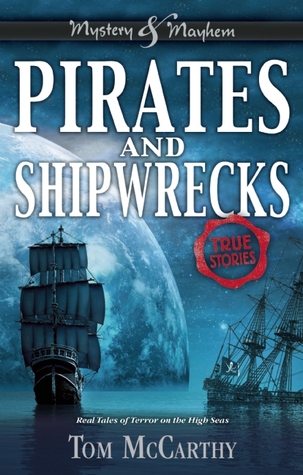 McCarthy, Tom. Pirates and Shipwrecks.
McCarthy, Tom. Pirates and Shipwrecks.October 11th 2016 by Nomad Press
Copy provided by the publisher
This 120 volume includes five stories: the escape of Daniel Collins; Captain Franklin's 1845 Arctic expedition; Mary Reed, a female pirate; the Wild Men of Andamans; and Barbarossa. Each story starts with a map of where it took place, and ends with a historic overview of what else was going on in the world at the time. The end of the book has a nice glossary for a variety of words students might not know. The stated Guided Reading Level on this is V, which apparently correlates to a 5-6th grade level .
 McCarthy, Tom. Survival
McCarthy, Tom. SurvivalOctober 11th 2016 by Nomad Press
Copy provided by the publisher
Using the same format as the book above, this volume covers the Shackleton Expedition; Captain Bligh and the Bounty; a man lost in Death Valley in the 1800s; the shipwreck survival of Charlotte Picard;
and the Donner Party.
In both of these books, there is enough background to understand why the circumstances were dire, and enough detail to make the tales of survival compelling. McCarthy has a nice, simple narrative form, but there are not many illustrations.
These are available in both hard cover and paperbound editions through Baker and Taylor. I'm a little torn about these. On the one hand, they are good tales of survival, but there is something about the presentation and language that make the books seem like they come from a boxed set of books used in reading intervention classes, yet the Lexile levels are awfully high for struggling readers (I frequently see 6th graders who are reading at a 2nd or 3rd grade level; they would struggle with both the length and complexity of these books). Nomad Press specifically publishes books with curricular tie-ins, and even has teaching guides for some of their books, although not for these at the time of review.
These stories would be interesting to use in a survival unit in language arts or history classes but might struggle to find readers who pick them up for pleasure reading since they are too difficult for struggling readers but a bit bland for more advanced readers.
 Ghigna, Charles. Strange, Unusual, Gross & Cool Animals
Ghigna, Charles. Strange, Unusual, Gross & Cool AnimalsOctober 11th 2016 by Animal Planet
Copy provided by publisher
This larger format, full color book gives brief snippets of information about a large variety of unusual animals. At the beginning, there is a page that discusses how the book is laid out, which is helpful. Some pages have multiple animals, there are a few "featured creatures" to which more space is devoted, and there are some "macroviews" which show more details. The index is also helpful; many books of this type lack them. Readers who are interested in biology, or who just want to show gross pictures to their classmates, will find this an engaging book. I do have my doubts about the survival of this book in a library setting-- the large size and paper-over-board covers give this an approximate life span of one year. This would be great as a gift for an individual.
 Yasuda, Anita and Crosier, Mike. Explore Greek Myths!: With 26 Great Projects
Yasuda, Anita and Crosier, Mike. Explore Greek Myths!: With 26 Great ProjectsOctober 11th 2016 by Nomad Press
Copy provided by publisher
This book packs in a lot of information about Ancient Greek history, mythology, and a variety of related information. Interspersed with this are ideas and instructions for projects relating to the topics, ranging from a Greek gods memory game to an experiment with pulleys. There are plentiful sidebars with vocabulary words, and even short jokes, indicated by a picture of a Cyclops. Project pages have red borders to set them apart. The book includes a glossary, index, and bibliography of both books and web sites. I was impressed that the oldest book in the bibliography was from 1992, and was D'Aulaire's Greek Myths, which is an essential work. I would have been more impressed, perhaps, if Edith Hamilton had also been cited!
Jam packed with information and ideas, this would be a good resource to use with students who are studying Ancient Greece, although the very busy format might be harder for students to use by themselves.
 Mooney, Carla and Casteel, Tom. The U.S. Constitution: Discover How Democracy Works with 25 Projects.
Mooney, Carla and Casteel, Tom. The U.S. Constitution: Discover How Democracy Works with 25 Projects.September 13th 2016 by Nomad Press
Divided into six chapters, this book is primarily concerned with the genesis of the constitution, a description of how it works, and includes a chapter on the important documents of other countries. The projects that accompany the extension information are geared more toward upper middle school, and while some crafts like calligraphy are involved, most of them are activities involving thinking and writing. This pages are helpfully set apart by a border similar to the red and blue on the cover. Each topic is accompanied by "Words to Know", "Did You Know" and "Essential question" features, and is illustrated with cartoons rather than photographs or copies of paintings.
The extensive information makes this a good supplement to a text, or an introduction to the Constitution and the other topics tangential to it (like democracy, US history, etc.). I can see history teachers using some of the activities as writing prompts, but I don't know that our 8th grade curriculum covers this in such depth that this many activities would be needed. Home schoolers might find this to be a helpful resource for a course of study that could spend more time on this topic.
























No comments:
Post a Comment